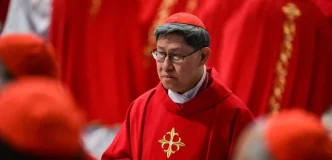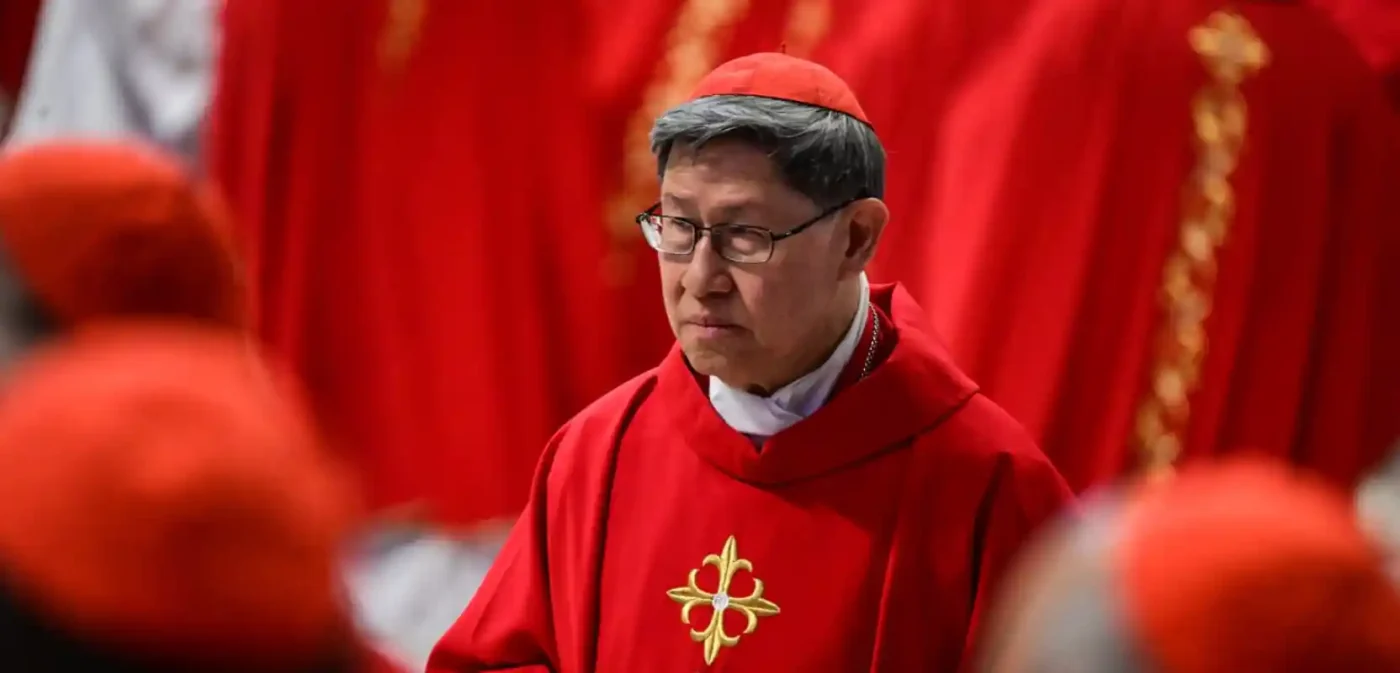As the iconic chimney of the Sistine Chapel prepares to release its first plumes of smoke, signaling the progress of the secretive papal conclave, a wave of anticipation has gripped Filipino Catholic communities worldwide. Among the 133 cardinals gathered to elect the successor to Pope Francis, Cardinal Luis Antonio Tagle stands out as a beacon of hope for many Filipinos, who dream of seeing one of their own ascend to the papacy—a historic first for the Philippines and Asia at large. The conclave, which began on May 8, 2025, in Vatican City, is not just a religious ritual but a moment of profound cultural and political significance for the 1.4 billion Catholics globally, including over 80 million in the Philippines.
A Filipino Pope? Dreams and Prayers
In the heart of Vatican City, Filipino pilgrims have joined the throngs of faithful awaiting news from the Sistine Chapel. Among them is Fr. Rey Matunog from the Archdiocese of Los Angeles, who led a group of 46 Filipino Americans on a pilgrimage to Rome and Switzerland. Their journey took on added significance with a special visit to the Vatican to support Cardinal Tagle, a prominent figure often mentioned in discussions of potential papal candidates. “We believe in the power of the Holy Spirit” said Fr. Matunog in an interview with a Filipino news outlet. “I hope the cardinals will be touched by the Spirit when choosing the next pope. Our faith is important now more than ever.”
Fr. Matunog’s sentiments reflect a broader yearning within the Filipino diaspora and back home in the Philippines, where Cardinal Tagle is seen not only as a spiritual leader but also as a symbol of national pride. “We pray that one of our Filipino cardinals, especially Cardinal Tagle, will be chosen as the new pope because it would be a blessing not only for the Church but also for Filipinos worldwide” he added. The possibility, though speculative, carries immense weight for a predominantly Catholic nation that has long played a significant role in the global Church but has yet to see an Asian pope in modern times.
The Conclave: A Centuries-Old Tradition
The papal conclave, steeped in centuries of tradition, began with the ceremonial cry of “extra omnes”—Latin for “all out”—as the doors of the Sistine Chapel closed to outsiders. Inside, 133 cardinals, including three from the Philippines—Cardinal Tagle, Cardinal Jose Advincula, and Cardinal Pablo Virgilio David—embarked on the sacred task of selecting the next leader of the Catholic Church. They entered in pairs, chanting the “Litany of the Saints,” a meditative hymn invoking divine guidance, while Swiss Guards stood watch.
The voting process, shrouded in secrecy, involves up to four ballots daily—two in the morning and two in the evening—until a candidate secures a two-thirds majority. Black smoke from the chapel’s chimney indicates no pope has been chosen, while white smoke will herald the election of a new pontiff. Historically, conclaves have varied widely in duration; Pope Francis was elected in just one day in 2013, whereas some elections, such as that of Pope Gregory X in 1271, stretched over three years. Vatican observers suggest the current conclave, which cast its first ballot on the evening of May 8, 2025, at 7 p.m. local time, is unlikely to conclude on the first day but may resolve within a few days.
Cardinal Tagle: A Global Figure with Filipino Roots
Cardinal Luis Antonio Tagle, often referred to as the “Asian Francis” due to his progressive views and charismatic presence, has long been considered a potential papal candidate. Born in Manila in 1957, Tagle rose through the ranks of the Church with a reputation for humility, pastoral care, and a deep commitment to social justice—qualities that resonate with the legacy of Pope Francis. Currently serving as the Pro-Prefect for the Section of Evangelization at the Dicastery for Evangelization, Tagle holds a prominent position in the Vatican, giving him visibility among his fellow cardinals.
His appeal extends beyond the Philippines. Tagle’s fluency in multiple languages, including English, Italian, and Tagalog, combined with his theological expertise and approachable demeanor, has earned him admiration across the Catholic world. He has been a vocal advocate for the poor and marginalized, often emphasizing the Church’s role in addressing inequality and climate change—issues that align with the priorities of the current pontificate. These attributes, observers note, could position him as a unifying figure at a time when the Church faces challenges ranging from declining membership in the West to internal debates over doctrine.
Yet, the likelihood of Tagle’s election remains uncertain. The conclave’s deliberations are famously opaque, guided by prayer, personal conviction, and, some speculate, subtle political alignments among cardinals. While Tagle’s name frequently appears in media discussions, Vatican analysts caution against premature predictions, noting that many factors, including regional representation and theological stances, influence the outcome. If chosen, Tagle would be the first Asian pope in modern history, following in the footsteps of regional representation that has seen Latin American and African cardinals gain prominence in recent decades.
Impact on the Philippines and Beyond
For the Philippines, a nation where Catholicism shapes cultural and political life, the prospect of a Filipino pope carries profound implications. The Church wields significant influence in the country, often acting as a moral compass on issues ranging from family values to government policy. A Pope Tagle could amplify the Philippines’ voice on the global stage, potentially drawing greater attention to regional concerns such as poverty, migration, and the effects of climate change on vulnerable communities in Southeast Asia.
In Manila’s poorer neighborhoods, where faith often provides solace amid hardship, news of the conclave has sparked hope and pride. Local reports describe residents gathering in churches and community centers to pray for Tagle, seeing his potential elevation as a source of inspiration. “It would show the world that Filipinos can lead, even in the highest places” said a street vendor in Imus, Tagle’s hometown, as quoted by a local outlet. Such sentiments underscore the emotional weight of the moment for a country that has faced economic struggles and natural disasters but remains deeply rooted in its Catholic identity.
Globally, Tagle’s candidacy, if it gains traction, could signal a shift in the Church’s center of gravity toward Asia, where Catholicism is growing rapidly compared to stagnating congregations in Europe and North America. With over 400 million Catholics in Asia—nearly a third of the global total—the region is increasingly seen as vital to the Church’s future. An Asian pope could energize outreach efforts, strengthen interfaith dialogue in diverse societies, and address unique challenges like religious persecution and secularization in countries such as China and India.
Challenges and Speculations
Despite the optimism surrounding Tagle, challenges remain. The conclave’s outcome hinges on complex dynamics among cardinals, many of whom may prioritize continuity with Pope Francis’ reforms or seek a leader from another region to balance global representation. Some Vatican watchers speculate that Tagle’s progressive leanings could face resistance from more conservative factions within the College of Cardinals, though no evidence confirms such divisions at this stage. His relative youth—Tagle is 67—could also be a double-edged sword, offering the potential for a long papacy but possibly deterring cardinals who prefer a shorter transitional pontificate.
Moreover, the historical rarity of non-European popes tempers expectations. While Pope Francis, an Argentine, broke the European mold in 2013, the majority of popes over the past millennium have hailed from Europe, particularly Italy. An Asian pontiff would mark a significant departure, one that may require a groundswell of support among cardinals attuned to the Church’s global diversity. Whether Tagle can muster such backing remains an open question, with answers hidden behind the Sistine Chapel’s sealed doors.
Awaiting the White Smoke
As the conclave unfolds over the coming days, the eyes of the world—and particularly those of Filipino Catholics—remain fixed on the Vatican. Each puff of smoke from the Sistine Chapel will carry with it the weight of history, hope, and faith. For now, speculation about Cardinal Tagle’s chances serves as a reminder of the Philippines’ deep connection to the Catholic Church and the broader aspirations of Asia’s faithful.
Whether or not Tagle emerges as the next pope, his presence among the cardinals underscores a pivotal moment for diversity within the Church. As ballots are cast and prayers are offered, the question lingers: could this be the year an Asian leader takes the helm of Catholicism, inspiring millions with a message of unity from the heart of Manila to the global stage?
















